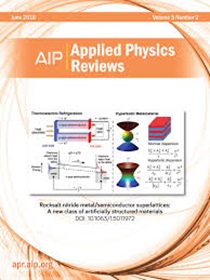Optical pulse-induced ultrafast antiferrodistortive transition in SrTiO3
IF 11.6
1区 物理与天体物理
Q1 PHYSICS, APPLIED
引用次数: 0
Abstract
The ultrafast dynamics of the antiferrodistortive phase transition in perovskite SrTiO3 is monitored via time-domain Brillouin scattering. Using femtosecond optical pulses, we initiate a thermally driven tetragonal-to-cubic structural transformation and detect the crystal phase through changes in the frequency of Brillouin oscillations (BO) induced by propagating acoustic phonons. Coupling the measured BO frequency with a spatiotemporal heat diffusion model, we demonstrate that, for a sample kept in the tetragonal phase, deposition of sufficient thermal energy induces a rapid transformation of the heat-affected region to the cubic phase. The initial phase change is followed by a slower reverse cubic-to-tetragonal phase transformation occurring on a timescale of hundreds of picoseconds. We attribute this ultrafast phase transformation in the perovskite to a structural resemblance between atomic displacements of the R-point soft optic mode of the cubic phase and the tetragonal phase, both characterized by anti-phase rotation of oxygen octahedra. The structural relaxation time exhibits a strong temperature dependence consistent with the prediction of the equation of motion describing collective oxygen octahedra rotation based on the energy landscape of the phenomenological Landau theory of phase transitions. Evidence of such a fast structural transition in perovskites can open up new avenues in information processing and energy storage sectors.光脉冲诱导的 SrTiO3 超快反铁氧体转变
我们通过时域布里渊散射监测了包晶 SrTiO3 中反铁锂相变的超快动态。利用飞秒光脉冲,我们启动了由热驱动的四方到立方的结构转变,并通过传播声子诱发的布里渊振荡(BO)频率变化来探测晶体相位。将测量到的布里渊振荡频率与时空热扩散模型相结合,我们证明,对于保持四方相的样品,足够的热能沉积会诱导热影响区域迅速转变为立方相。初始相变之后,立方相向四方相的反向相变速度较慢,其时间尺度为数百皮秒。我们将包晶石中的这种超快相变归因于立方相和四方相的 R 点软光学模式原子位移之间的结构相似性,两者都以氧八面体的反相旋转为特征。结构弛豫时间表现出很强的温度依赖性,这与描述氧八面体集体旋转的运动方程根据相变现象学朗道理论的能量景观预测的结果一致。有证据表明过氧化物中存在如此快速的结构转变,这将为信息处理和能量存储领域开辟新的途径。
本文章由计算机程序翻译,如有差异,请以英文原文为准。
求助全文
约1分钟内获得全文
求助全文
来源期刊

Applied physics reviews
PHYSICS, APPLIED-
CiteScore
22.50
自引率
2.00%
发文量
113
审稿时长
2 months
期刊介绍:
Applied Physics Reviews (APR) is a journal featuring articles on critical topics in experimental or theoretical research in applied physics and applications of physics to other scientific and engineering branches. The publication includes two main types of articles:
Original Research: These articles report on high-quality, novel research studies that are of significant interest to the applied physics community.
Reviews: Review articles in APR can either be authoritative and comprehensive assessments of established areas of applied physics or short, timely reviews of recent advances in established fields or emerging areas of applied physics.
 求助内容:
求助内容: 应助结果提醒方式:
应助结果提醒方式:


